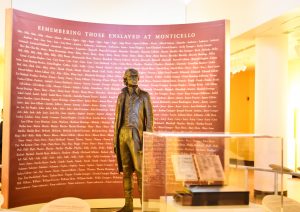
(Photo: Rachel Hawkins/ NDG)
By Rachel Hawkins, NDG Staff Writer
American history, especially African American history, is an intriguing yet contradictory concept. The ugly story of slavery is well known, but much more remains for discovery, and Dallas is one of the first to provide a renewal examination.
Slavery at Jefferson’s Monticello: Paradox of Liberty is a groundbreaking traveling exhibit on display at the African American Museum in Fair Park from Sept. 22 until Dec. 31. The widely acclaimed exhibition chose Dallas as the first stop.
Over 300 objects of works of art, documents, and artifacts excavated from the plantation will be on display at the museum. There will also be a unique feature on Sally Hemings, famously known as Thomas Jefferson’s slave and mother of six of his children. There is extensive debate over their controversial relationship with Jefferson.
This exhibit will also challenge how the author of the Declaration of Independence, Thomas Jefferson, a man who called slavery “an abominable crime” yet wrote the famous words, “all men are created equal,” could also own 607 slaves over his lifetime. In the age of Jefferson, slaves were not considered citizens and were deemed to have a three-fifths value of a person for taxation purposes.
Visitors will have an opportunity to meet six slave families who lived and worked at Monticello. Their stories will delve into topics ranging from life as a slave during Jefferson’s lifetime to their descendant quest for freedom.
The idea of the exhibit began two years ago when Dallas City Councilmember Kevin Felder and Gayle Jessup White, Monticello’s Community Engagement Officer and a descendant of Hemings and Jefferson shared a cab and discussed the idea.
“Later on we had dinner and talked about bringing the exhibition to Dallas,” Felder shared during a recent media tour. “During dinner, I told her I was a close friend of Dr. Robinson, (Harry Robinson, Jr., President, and CEO of the African American Museum, in Dallas). I called him and told him I was sitting with Gayle Jessup White, a descendant of Jefferson, and ask ‘would you be interested in bringing the exhibition to Dallas?’ He said yes, and that was in July of 2016.”
Felder personally felt the exhibition provides a launching point for a conversation needed throughout America in 2018.
“I’m especially excited that this accomplishment is beginning here in the City of Dallas,” Felder said. “Out of all the issues we have here, I think this is timely that we have this exhibition and look at the history of slavery and the plight of African Americans that journeyed to America.”
As stated in the press release, the exhibit brings individuals and families out of the shadows of chattel slavery, pulling from more than 50 years of archaeology, documentary research, and oral histories to fill in the critical human dimension missing from many resources on slavery in the United States.
According to the Jefferson Foundation’s website, “Mulberry Row was the dynamic, industrial hub of Jefferson’s 5,000-acre agricultural enterprise. As the principal plantation street, it was the center of work and domestic life for dozens of people — free whites, free blacks, indentured servants, and enslaved people. It was populated by more than 20 dwellings, workshops, and storehouses between 1770 and the sale of Monticello in 1831.”
Several items from Mulberry Row are also on display at the Dallas exhibit. Many of the items found at the plantation were personal items such as a shoe, clothing buckle, and metal buttons, and other items from coins, animal bones, and locks.
“These are items that were exhibited with the department of archeology at Monticello,” Tabitha Corradi, Collections and Exhibitions Manager at Thomas Jefferson Foundation said. “These are personal items that would have come from the enslaved dwellings and buildings.”
Slavery at Jefferson’s Monticello: Paradox of Liberty is a Smithsonian Institution exhibit that will be on display at Fair Park’s African American Museum of Dallas from Sep. 22-Dec. 31, 2018. Tickets are available at Eventbrite.com.








